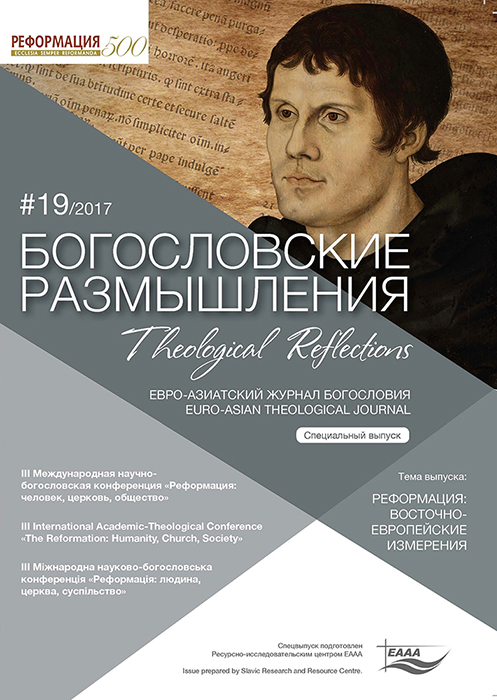“A feast during the plague”. Images of union with Christ and of the Kingdom of Heavens in the hymns of Philipp Nicolai
DOI:
https://doi.org/10.29357/issn.2521-179X.2017.19.61Keywords:
Hymns, Theology, Eschatology, Mystic, HymnologyAbstract
After a short introduction on Philipp Nicolai’s (1556-1608) biography and his sharp polemic theology, two of his famous hymns, “the king and queen of Lutheran hymns” written during an epidemic of the plague in Unna, are analysed. Their linguistic and theological characteristics, which have to do with the brilliant use of biblical images and with a sensual mysticism in the spirit of Bernard Clairvaux which seems very provocative today as well as with the anticipation of the Kingdom of Heaven full of untroubled excitement, are shown. Using the example of some characteristics of these hymns, the lecturer illustrates the attitude of Luther and the Lutheran church to music as to a “natural Gospel” and to poetry as to a means for expressing the divine.
References
- REFERENCES
- Buchrucker, Armin-Ernst. Theologie der evangelischen Abendmahlslieder. Erlangen, Martin-Luther Verlag 1987.
- Denecke, Axel. “Gott ist bei uns…“ In Theo-Poesie. Dietrich Bonhoeffers späte Wende zu einer poetischen Theologie. Wiesbaden-Berlin, Fenestra-Verlag, 2014.
- Evangelisches Gottesdienstbuch. Agende für die Evangelische Kirche der Union und für die Vereinigte Evangelisch-Lutherische Kirche Deutschlands. Berlin, Luther-Verlag 1999.
- Geistliches Wunderhorn. Große deutsche Kirchenlieder. München, Verlag C.H. Beck, 2003.
- Kleck, Konrad “In dulchi jubilo – süße Musik, bitte sehr!“ in Eckart Liebau, Jörg Zirfas (Hg.), Die Bildung des Geschmacks. Über der Kunst der sinnlichen Unterscheidung. Bielefeld, Transcript Verlag 2011.
- Liederkunde. Handbuch zum Deutschen Evangelischen Gesangbuch nebst dem Rheinisch-Westfälischen Sondergut, bearbeitet von Johannes Plath und Johannes Kulp, Band I, Die Texte. Dortmund, Verlag von W, Grüwell 1931.
- Müller, Dedo. Musik als Problem lutherischer Gottesdienstgestaltung. Berlin, Evangelischer Verlagsanstalt, 1947.
- Peter C. A. Schels, Kleine Enzyklopädie des deutschen Mittelalters. Eine lexikalische Materialsammlung zum Mittelalter, schwerpunktmäßig im deutschsprachigen Raum: http://u01151612502.user.hosting-agency.de/malexwiki/index.php/Mystik
- Roper, Lyndal. Der Mensch Martin Luther. Die Biografie. Frankfurt, S. Fischer, 2016.
- Rößler, Martin. Liedermacher im Gesangbuch. Liedgeschichte in Lebensbildern. Stuttgart, Calwer Verlag, 2001.
- Schilling, Heinz. Martin Luther. Rebell in einer Zeit des Umbruchs. München, Verlag C. H. Beck, 2013.
- Schwanke, Johannes. Creatio ex nihilo. Luthers Lehre von der Schöpfung aus dem Nichts in der Großen Genesisvorlesung (1535-1545). Berlin-New York, De Gruyter, 2004.
- Söhngen, Ockar. Theologie der Musik. Kassel, Johannes Stauda Verlag, 1967.
- Gimny dlia khristian evangelicheskoliute ranskogo veroispovedaniia. СПб, Карл Риккер, 1905.
- Gimny nadezhdy. Sbornik khristianskikh gimnov. Издательство “Источник жизни”, 2001.
- Psalmy Siona. Sbornik dukhovnykh pesnopenii bez not. 8-е издание. Киев, Джерело Життя, 2002.
- Sbornik pesnopenii Evangelichesko-Liuteranskoi Tserkvi. СПб., Евангелическо-Лютеранская Церковь, 2009.
Downloads
Published
How to Cite
Issue
Section
License
Copyright (c) 2020 Anton Tikhomirov

This work is licensed under a Creative Commons Attribution-NonCommercial 4.0 International License.
All articles published in the Journal are distributed under a Creative Commons Attribution-NonCommercial 4.0 International License
By submitting an article for publication in Theological Reflections: Eastern European Journal of Theology the author grants the editors the right to publish the article and distribute it in electronic and print form.
The author reserves all copyrights and the right to use the materials of the article in whole or in part for educational purposes, to write his own dissertations, to prepare abstracts, conference reports, oral presentations, etc., as well as post electronic copies of articles (including the final electronic version downloaded from the journal’s official website) on non-commercial web-resources without the consent of the editorial board and founders.



